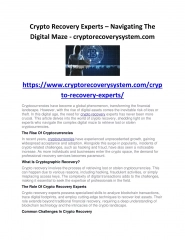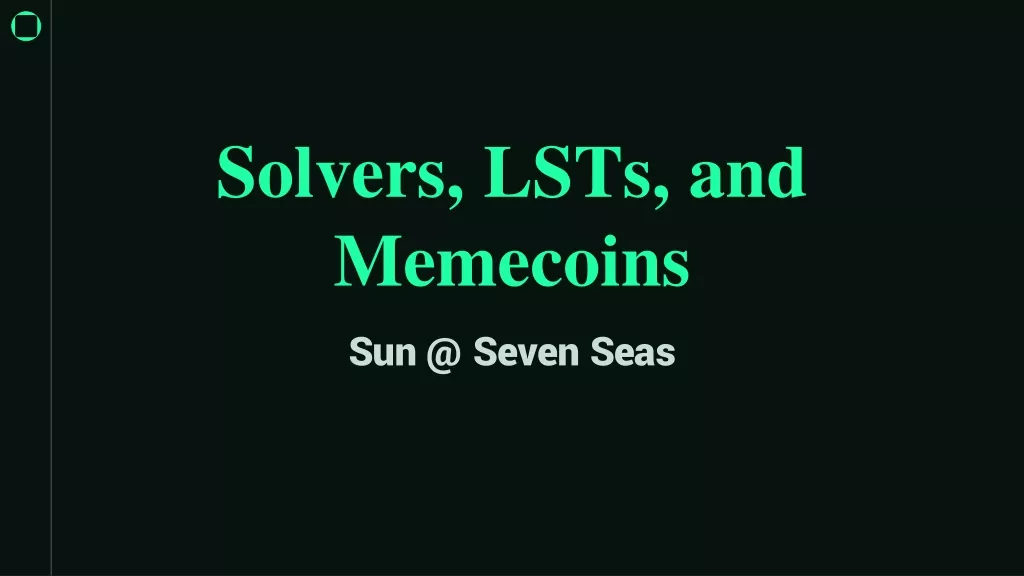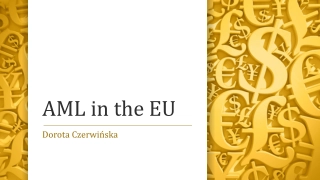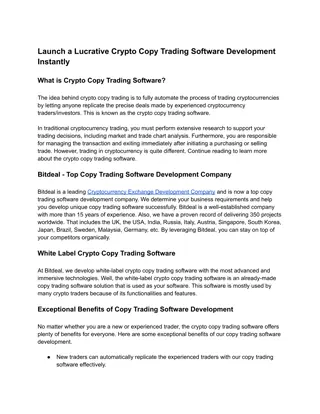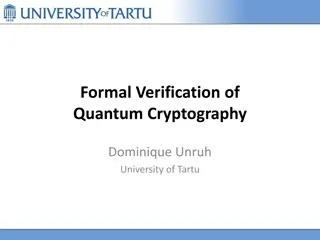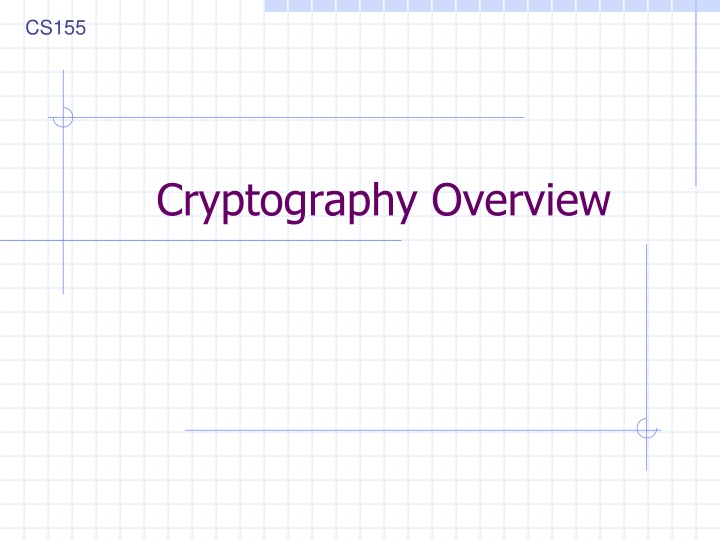
Cryptography Overview and Security Principles
Learn about the fundamentals of cryptography, its importance in ensuring secure communication, and key principles such as Kerckhoffs's principle. Explore symmetric cryptography, secure communication goals, and use cases like one-time pads. Discover how cryptography plays a crucial role in modern security mechanisms.
Download Presentation

Please find below an Image/Link to download the presentation.
The content on the website is provided AS IS for your information and personal use only. It may not be sold, licensed, or shared on other websites without obtaining consent from the author. If you encounter any issues during the download, it is possible that the publisher has removed the file from their server.
You are allowed to download the files provided on this website for personal or commercial use, subject to the condition that they are used lawfully. All files are the property of their respective owners.
The content on the website is provided AS IS for your information and personal use only. It may not be sold, licensed, or shared on other websites without obtaining consent from the author.
E N D
Presentation Transcript
CS155 Cryptography Overview
Cryptography Is A tremendous tool The basis for many security mechanisms Is not The solution to all security problems Reliable unless implemented properly Reliable unless used properly Something you should try to invent or implement yourself
http://upload.wikimedia.org/wikipedia/commons/thumb/6/68/Kerkhoffs.jpg/180px-Kerkhoffs.jpghttp://upload.wikimedia.org/wikipedia/commons/thumb/6/68/Kerkhoffs.jpg/180px-Kerkhoffs.jpg Kerckhoff s principle A cryptosystem should be secure even if everything about the system, except the secret key, is public knowledge.
Goal 1:secure communication Step 1: Session setup to exchange key Step 2: encrypt data
Goal 2: Protected files Disk Alice Alice File 1 No eavesdropping No tampering File 2 Analogous to secure communication: Alice today sends a message to Alice tomorrow 5
Symmetric Cryptography Assumes parties already share a secret key
Building block: sym. encryption nonce Alice Bob m, n D(k,c,n)=m c, n E(k,m,n)=c E D k k E, D: cipher k: secret key (e.g. 128 bits) m, c: plaintext, ciphertext n: nonce (aka IV) Encryption algorithm is publicly known Never use a proprietary cipher
Use Cases Single use key: (one time key) Key is only used to encrypt one message encrypted email: new key generated for every email No need for nonce (set to 0) Multi use key: (many time key) Key used to encrypt multiple messages files: same key used to encrypt many files
First example: One Time Pad (single use key) Vernam (1917) Key: 0 1 0 1 1 1 0 0 1 0 Plaintext: 1 1 0 0 0 1 1 0 0 0 Ciphertext: 1 0 0 1 1 0 1 0 1 0 Shannon 49: OTP is secure against ciphertext-only attacks
Stream ciphers (single use key) Problem: OTP key is as long the message Solution: Pseudo random key -- stream ciphers key c PRG(k) m PRG message ciphertext Stream ciphers: ChaCha (643 MB/sec) 1
Dangers in using stream ciphers One time key !! Two time pad is insecure: C1 m1 PRG(k) C2 m2 PRG(k) Eavesdropper does: C1 C2 m1 m2 Enough redundant information in English that: m1 m2 m1 , m2
Block ciphers: crypto work horse n Bits n Bits E, D PT Block CT Block k Bits Key Canonical examples: 1. 3DES: n= 64 bits, k = 168 bits 2. AES: n=128 bits, k = 128, 192, 256 bits IV handled as part of PT block
Building a block cipher Input: (m, k) Repeat simple mixing operation several times DES: Repeat 16 times: mL mR mR mL F(k,mR) AES-128: Mixing step repeated 10 times Difficult to design: must resist subtle attacks differential attacks, linear attacks, brute-force,
Block Ciphers Built by Iteration key k key expansion k1 k2 k3 kn R(kn, ) R(k1, ) R(k2, ) R(k3, ) m c R(k,m): round function for DES (n=16), for AES-128 (n=10)
Incorrect use of block ciphers Electronic Code Book (ECB): PT: m1 m2 c2 c1 CT: Problem: if m1=m2 then c1=c2
Correct use of block ciphers: CTR mode E(k,x): maps key k and n-bit block x to a n-bit block y Counter mode (CTR) with a random IV: IV m[0] m[1] m[L] E(k,IV+L) E(k,IV) E(k,IV+1) IV c[0] c[1] c[L] ciphertext Note: Parallel encryption
Use cases: how to choose an IV Single use key: no IV needed (IV=0) Multi use key: (CPA Security) Best: use a fresh random IV for every message Can use unique IV benefit: may save transmitting IV with ciphertext (e.g 0, 1, 2, 3, ) uniqueIV counter 128 bits
In pictures encrypt with CTR Why is CTR secure? not today
Performance: [openssl speed] Intel Core 2 (on Windows Vista) Cipher Block/key size Speed (MB/sec) ChaCha 643 3DES AES-128/GCM 64/168 128/128 30 163 AES is dramatically faster with AES-NI instructions: Intel SkyLake: 4 cycles per round, fully pipelined AESENC xmm15, xmm1
Message Integrity: MACs Goal: message integrity. No confidentiality. ex: Protecting public binaries on disk. k k Message m tag Alice Bob Verify tag: V(k, m, tag) = `yes Generate tag: tag S(k, m) ? note: non-keyed checksum (CRC) is an insecure MAC !!
Secure MACs Attacker information: chosen message attack for m1,m2, ,mq attacker is given ti S(k,mi) Attacker s goal: existential forgery. produce some new valid message/tag pair (m,t). (m,t) { (m1,t1) , , (mq,tq) } A secure PRF gives a secure MAC: S(k,m) = F(k,m) V(k,m,t): `yes if t = F(k,m) and `no otherwise.
Construction 1: ECBC m[0] m[1] m[2] m[3] E(k, ) E(k, ) E(k, ) E(k, ) Raw CBC tag key = (k, k1) E(k1, )
Construction 2: HMAC (Hash-MAC) Most widely used MAC on the Internet. H: hash function. example: SHA-256 ; output is 256 bits Building a MAC out of a hash function: Standardized method: HMAC S( k, m ) = H( k opad || H( k ipad || m ))
SHA-256: Merkle-Damgard m[0] m[1] m[2] m[3] H(m) IV h h h h h(t, m[i]): compression function Thm 1: if h is collision resistant then so is H Thm 2 : if h is a PRF then HMAC is a PRF
Why are these MAC constructions secure? not today take CS255 Why the last encryption step in ECBC? CBC (aka Raw-CBC) is not a secure MAC: Given tag on a message m, attacker can deduce tag for some other message m How: good crypto exercise
Authenticated Encryption: Encryption + MAC
Combining MAC and ENC (CCA) Encryption key KE MAC key = KI Option 1: MAC-then-Encrypt (SSL) MAC(M,KI) Enc KE Msg M Msg M MAC Option 2: Encrypt-then-MAC (IPsec) MAC(C, KI) Enc KE Secure for all secure primitives MAC Msg M Option 3: Encrypt-and-MAC (SSH) MAC(M, KI) Enc KE MAC Msg M
Recommended mode (currently) AES-GCM: encrypt-then-MAC Counter mode AES Carter-Wagman MAC
Public key encryption: (Gen, E, D) Gen pk sk m c c m E D
Applications Session setup (for now, only eavesdropping security) Bob Alice pk Generate (pk, sk) choose random x (e.g. 48 bytes) E(pk, x) x Non-interactive applications: (e.g. Email) Bob sends email to Alice encrypted using pkalice Note: Bob needs pkalice(public key management)
Applications Encryption in non-interactive settings: Encrypted File Systems skA read write Alice E(pkA, KF) File Bob E(kF, File) E(pkB, KF)
Applications Encryption in non-interactive settings: Key escrow: data recovery without Bob s key Escrow Service skescrow write E(pkescrow, KF) Bob E(kF, File) E(pkB, KF)
Trapdoor functions (TDF) Def: a trapdoor func. X Y is a triple of efficient algs. (G, F, F-1) G(): randomized alg. outputs key pair (pk, sk) F(pk, ): det. alg. that defines a func. X Y F-1(sk, ): func. Y X that inverts F(pk, ) Security: F(pk, ) is one-way without sk
Public-key encryption from TDFs (G, F, F-1): secure TDF X Y (Es, Ds) : symm. auth. encryption with keys in K H: X K a hash function We construct a pub-key enc. system (G, E, D): Key generation G: same as G for TDF
Public-key encryption from TDFs (G, F, F-1): secure TDF X Y (Es, Ds) : symm. auth. encryption with keys in K H: X K a hash function D( sk, (y,c) ) : x F-1(sk, y), k H(x), m Ds(k, c) output m E( pk, m) : x X, y F(pk, x) k H(x), c Es(k, m) output (y, c) R
In pictures: Es( H(x), m ) F(pk, x) header body Security Theorem: If (G, F, F-1) is a secure TDF, (Es, Ds) provides auth. enc. and H: X K is a random oracle then (G,E,D) is CCAro secure.
Digital Signatures Public-key encryption Alice publishes encryption key Anyone can send encrypted message Only Alice can decrypt messages with this key Digital signature scheme Alice publishes key for verifying signatures Anyone can check a message signed by Alice Only Alice can send signed messages
Digital Signatures from TDPs (G, F, F-1): secure TDP X X H: M X a hash function Verify( pk, m, sig) : output 1 if H(m) = F(pk, sig) 0 otherwise Sign( sk, m X) : output sig = F-1(sk, H(m) ) Security: existential unforgeability under a chosen message attack (in the random oracle model)
Public-Key Infrastructure (PKI) Anyone can send Bob a secret message provided they know Bob s public key How do we know a key belongs to Bob? If imposter substitutes another key, can read Bob s messages One solution: PKI Trusted root Certificate Authority (CA) CA certifies that a given public-key belongs to Bob more on this next time
Putting it all together: SSL/TLS (simplified) Client-hello Server-hello Key exchange Server-key-exchange S C Client key-exchange finished finished Confirmation Encrypted session
Limitations of cryptography Cryptography works when used correctly !! but is not the solution to all security problems XKCD 538


